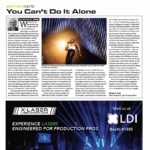All my life I've been waiting for someone to build a flying car. It's kind of like waiting for Donald Trump to lose the rest of his hair; we're pretty sure it's going to happen, we just don't know when. Whether we're talking about the Donald's hair falling out or cars flying in, when it does happen it will be a big improvement but far too expected not to be anti-climactic. That's the problem with anticipating the future of technology – if you know it's coming, it takes some of the fun out of it.
That's why my iPhone and I really get along well. Until I got it a few months ago, I had no idea that I couldn't live without it. Now we're constant companions and often entertain each other while waiting in line (that's Texan for what some of you call waiting on line) or on hold. I check my email, update my Facebook status, check my bank balance, send text messages or listen to music. Sometimes I use it to take pictures, shoot video, find my way around town, check my appointment schedule or manage contacts. Then there are a slew of apps that I use, and some that I have yet to download and use. Oh yeah – every once in a while, I use it for a telephone.
One of those apps that I have yet to use, but that I will use very soon, is called ScanLife. It allows you to scan barcodes and get additional content or information about a variety of things, including ads in this magazine. Sometimes we just don't have enough space in these pages to include all of the content we would like to. Now we can print a 2D barcode that you can scan with your smart phone and it will take you to a site with the added content. You will also find a variety of ads with 2D barcodes that link to more information about those products and services.
Last month, I had the opportunity to attend a class on automation at Fisher Technical Services, Inc. in Las Vegas. The five-day course covered the basics of programming the Navigator software as well as setting up and operating the automated winches. To say that the class was an eye-opener is an understatement. Although I've seen many shows that use automation, this class exposed me to the potential of the technology and vividly illustrated not only its capabilities but also its possibilities. We had the opportunity to learn the entire system, including the software and the hardware, program cues, and play with live loads on automated winches. Along the way, we got to see video of some very creative and cutting-edge applications.
One such application was a movie shoot using a camera on an automated track which followed a car being driven through a wall. Just before it went through the wall, the car "hit" a stunt man in a harness attached to automated winch. The system was programmed so that the winch retracted the stunt man just before the car hit him, and at regular speed, it looked as if the car hit him and propelled him backward.
Another example we saw was a kinetic sculpture with video mapping. It has over 1,000 white plastic balls about 8 inches in diameter, each flown with an automated winch. A pixel-mapping application in Navigator translates video input into movement, creating an incredibly organic moving sculpture. It looked like a living, breathing organism.
I posted a few words about the class on ProLightingSpace.com after each of the five days. To see pictures from the event and read more about it, go to ScanLife (scanlife.com) and download the 2D barcode reader application, and then scan the barcode on page 4 of the May issue of PLSN to visit the site.
We still don't have flying cars, but what we have is far better. We have the technology to deliver entertainment at its finest.


